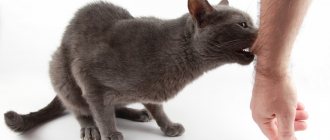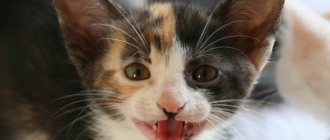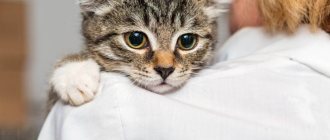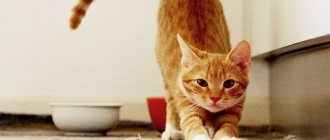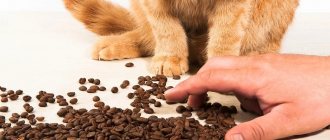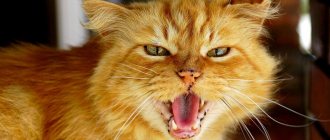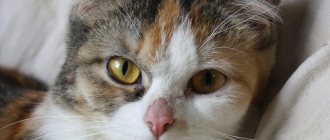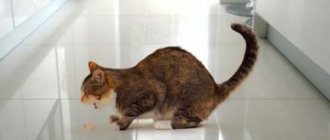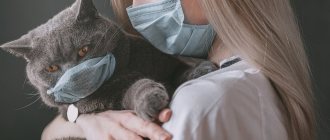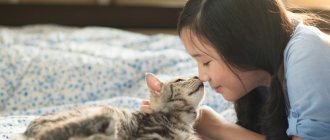Veterinary specialists regularly encounter complaints that cats often vomit hair. If this happens weekly or less often, then there is nothing to be afraid of - this is a normal process of cleansing the intestines. Repeated daily vomiting is a concern, which may indicate the development of a chronic disease or the formation of a large hairball in the stomach.
Let's find out whether you can cope with the problem yourself, and when you need urgent help from a specialist.
Is vomiting hair normal?
Cats constantly lick themselves, swallowing large amounts of fur, but cannot digest it.
Therefore, nature has a cleansing mechanism that allows you to get rid of it. The gastrointestinal tract of animals is designed in such a way that hairs accumulate in the stomach, but enter the intestines in minimal quantities.
The body periodically needs cleansing, so the gag reflex is triggered. The pet vomits wool sausages or dense lumps.
What frequency of regurgitation would be normal?
It is considered normal if a cat vomits hair about three times every 2-3 months. But these data are relative. What matters is the thickness, length of the coat, general health, and molting periods.
Why do hairballs form?
Scientifically, the wool balls or sausages that form in the stomach and intestines of a cat are called trichobezoar (“hair tumor”) - a mixture of hairs, food debris and gastric mucus.
Sometimes a cat vomits hair
The reason for their formation is that representatives of the cat family carefully care for their fur using their tongue. The fact is that it is covered with small hook-shaped growths, which, when licked, pick up hairs. Next, individual hairs pass into the animal’s stomach, where they accumulate in the form of balls or sausages and are periodically released with vomit.
Small accumulations pass through the digestive tract further into the duodenum and small intestine, then are excreted in the feces. A large lump can get stuck in the intestines and cause constipation or obstruction, stricture and esophagitis.
Hairballs from a cat's stomach
Natural causes
If the ingested hairs are not excreted, the cat will periodically regurgitate the hair to remove these non-food items from the stomach. Because the wool masses pass through a narrow esophagus, they look like sausages. In this case, vomiting is accompanied by coughing sounds.
In long-haired breeds (Persians, Maine Coons and others), this natural cause of the formation of trichobezoars is most common - they can spend more than 10% of their time licking their coat.
Cats swallow fur when licking themselves.
Additional Information! Kittens practically never have such lumps in their vomit, because they are licked by the mother cat, but as they grow, vomiting of swallowed fur in a young cat becomes more and more common.
The cause of vomiting itself can also be grass specially eaten by the animal for cleansing.
Dangerous reasons
If your cat vomits hair quite often, you need to visit a veterinary clinic so as not to miss the onset of a serious illness in your pet.
So, some dangerous reasons why a cat pulls out hairballs and swallows them are:
- Flea infestation. At the same time, the volume of ingested fur sharply increases as a result of itching from bites.
- Allergic dermatitis and other skin problems, the symptoms of which are unbearable itching.
- Being in stressful situations, when the animal licks itself to calm itself, as well as as a result of increased excitability of the sympathetic nerves.
- Chronic diseases of the gastrointestinal tract due to an inappropriate diet, accompanied by impaired motility of the upper digestive tract.
- Diabetes, kidney and thyroid diseases, intestinal inflammation.
Causes of vomiting
Periodic vomiting of fur in cats is normal. This is a natural physiological process.
The reasons for frequent vomiting are as follows:
- an increase in the amount of wool ingested;
- deterioration of motility in the upper gastrointestinal tract.
The following factors can provoke an increase in the volume of ingested fur:
- fleas leading to the development of allergic dermatitis;
- pathologies of the skin that provoke itching;
- exposure to stress.
A decrease in gastrointestinal motility is observed in the presence of pathologies of the gastrointestinal tract that occur in a chronic form. Negative changes are observed with food intolerance. In this case, colitis is possible, and blood appears in the stool.
Daily nausea
Vomiting observed every day indicates problems with the digestive system. The following negative changes provoke the onset of the pathological process:
- inflammation of the rectum;
- pancreatitis;
- triaditis;
- malignant tumors;
- lymphoma;
- carcinoma.
Frequent vomiting is provoked by stress, so special attention should be paid to the psycho-emotional state of the pet.
Increase your water consumption
If your cat eats dry food, there is likely not enough water in her diet to meet her fluid needs. Thus, their digestive system may not function properly.
Offer your cat a source of clean, fresh water
Many felines are very picky about the taste of water and do not like to drink from the tap. And they may not like the smell or taste of tap water. You might consider buying your cat purified water to encourage her to drink more.
Presence of undigested food in vomit
There are several reasons for the appearance of such symptoms. Among the most common are the following:
- Rapid absorption of food, overeating.
- Poor quality food. If there is a lack of protein in the feed, the absorption of nutrients slows down. The meat content in cheap feeds is only about 3%. The lack of protein is compensated by adding offal; it is also possible that there are chemicals in the composition, all of which can cause vomiting.
- Poisoning.
- Infectious diseases.
- Pancreatitis, colitis, gastritis.
- Intestinal inflammation.
- Helminthic infestations.
Poisoning
The first cause of vomiting in a cat is poisoning. Essentially, the gag reflex is the result of evolutionary processes. When toxic substances enter the body, protective mechanisms are automatically activated, which should, as quickly as possible, prevent toxins from entering the blood and spreading to all organs. In case of poisoning, nausea is accompanied by diarrhea and colic. Most often, intoxication occurs when it enters the digestive system of pets:
- hygienic and cleaning household solutions;
- medicines;
- chemical fertilizers for indoor plants;
- antifreeze;
- bait for rodents.
In addition, poisoning is caused by spoiled food
Vomiting in kittens
Nausea in small kittens is extremely dangerous. The younger the pet, the more difficult it is to save it, even if timely medical care is provided. The resulting dehydration leads to death in the shortest possible time.
Often, nausea in a kitten begins due to congenital problems with the digestive system. The difficulty of therapy lies in the unpredictable reaction of the body to medications.
From the age of three months, the causes of negative changes in kittens are identical to the problems of adult animals.
Diseases
The cause of vomiting in a cat is often infection:
- panleukopenia infection, characterized by a severe and acute course and the release of greenish fluid (urgent medical attention is required);
- coronavirus enteritis is a dangerous disease during which the epithelium of the small intestine becomes inflamed (the main symptom is constant vomiting of blood and bile);
- the disease hypocortisolism causes destabilization of the adrenal glands (vomit comes out with white foam);
- hypothyroidism the animal begins to quickly lose weight due to the fact that its glands practically stop producing the hormone cortisone.
Unvaccinated kittens often suffer from calcivirus, which is called cat flu. The disease is accompanied by constant vomiting.
How to help your pet
Your doctor should tell you what to do if such problems arise.
It is important to identify the exact cause of vomiting . Therapy is carried out using medications. Traditional recipes can also be effective.
Preparations for removing hair from the body
Veterinary pharmacies sell special pastes that help remove hair from the stomach before lumps form, i.e. until the stage when digestive problems begin to develop.
The drugs are given strictly according to the instructions, they help:
- relieve your pet from nausea, constipation, intestinal blockage;
- eliminate loss of appetite;
- strengthen the coat, make it smooth and shiny.
Traditional methods
Folk methods will help to cope with the problem. Vaseline oil is used. Take 4 ml of the product into a syringe and pour it into the cat’s mouth in small portions.
It is important that the pet has time to swallow each portion. Due to this, the intestines are cleansed.
You can add 3-4 drops of fish oil or flaxseed oil to the food. These products also promote natural hair removal from the body.
Veterinary pharmacies and specialty pet stores sell grass seeds that can be grown at home as a houseplant.
It contains many vitamins and nutrients that a cat needs for development and normal life. When it is eaten, the animal’s stomach is cleansed of accumulated lumps.
Add more fiber to feed
Just like humans, cats need fiber to maintain a healthy digestive tract. However, their needs differ from those of humans and other omnivores because they generally do not require plant fiber.
However, adding some fiber to your cat's diet can help reduce the risk of hairballs by helping them move better through the digestive system.
Some forms of added fiber include:
- Pumpkin (or pumpkin powder)
- Apples
- Carrot
- cat grass
- Metamucil (fiber pill or powder)
Keep in mind that cats' fiber needs are very different from those of humans. You don't want to add too much to their diet, or your cat may experience unpleasant side effects. If you are unsure how much to add, talk to your cat's veterinarian.
When you can’t do without veterinary help
Sometimes pets, while taking medications or excessively overeating food and grass, accumulate a large amount of hair. The animal cannot get rid of it on its own. Need help from a veterinarian.
The following symptoms are dangerous:
- daily nausea;
- the contents are released not in the form of sausages or lumps, but in separate shreds, the presence of stomach contents, mucus, and blood inclusions is noted;
- attempts to spit out the lump fail;
- the animal's fur loses its shine, the cat looks untidy, stops washing itself and licking itself;
- stool is hard, dense;
- constipation;
- presence of wool particles in feces;
- poor appetite, complete refusal to eat;
- cough;
- lethargy, apathy. The cat stops playing and tries to hide;
- the stomach is swollen and painful.
Such symptoms indicate the presence of serious problems with the gastrointestinal tract, intestinal obstruction. It is necessary to begin therapy under strict medical supervision.
If medications fail to relieve unpleasant symptoms, then surgical intervention is resorted to.
What happens if a hairball gets into a cat's intestines?
If the trichobezoar is small and has advanced into the intestine, then with good peristalsis it will be released naturally, with feces, without any unpleasant consequences.
If the hairball is sufficiently dense and large, then blockage of the intestinal lumen may occur, which is clinically expressed as constipation, abdominal pain, lethargy and apathy. The cat experiences discomfort and stops eating and playing.
Due to blockage, the intestinal walls become inflamed, and blood may appear when attempting to defecate or in small amounts of stool.
In such situations, it is necessary to give the cat at least 20 ml of Vaseline oil, and if the animal does not go “big” within 24 hours, you need to go to the veterinary clinic. The doctor will conduct an examination, determine the location of the problem and prescribe appropriate treatment.
In rare cases, surgical removal of conglomerate from wool is prescribed.
Important! A cat with a complete blockage of the intestinal lumen will die in a few days without veterinary care, so you can’t hesitate!
Types of vomit
Owners of mustachioed animals should not only know the causes of vomiting in cats, but also the types of discharge:
- the appearance of white foam indicates a full stomach or the development of gastritis;
- if clear mucus comes out with food, most likely your cat has become infected with worms or has chronic gastritis;
- the release of gray mass along with the remains of digested food is considered a normal physiological process;
- green liquid is released during poisoning, infections, gastrointestinal dysfunction, liver and gallbladder diseases;
- if a cat is vomiting blood, it means that bleeding has occurred in one of the sections of the gastrointestinal tract as a result of foreign objects or an ulcer;
- the appearance of black liquid indicates intestinal obstruction;
- yellow fluid may indicate liver damage.
